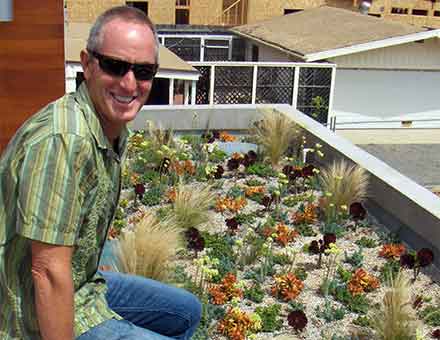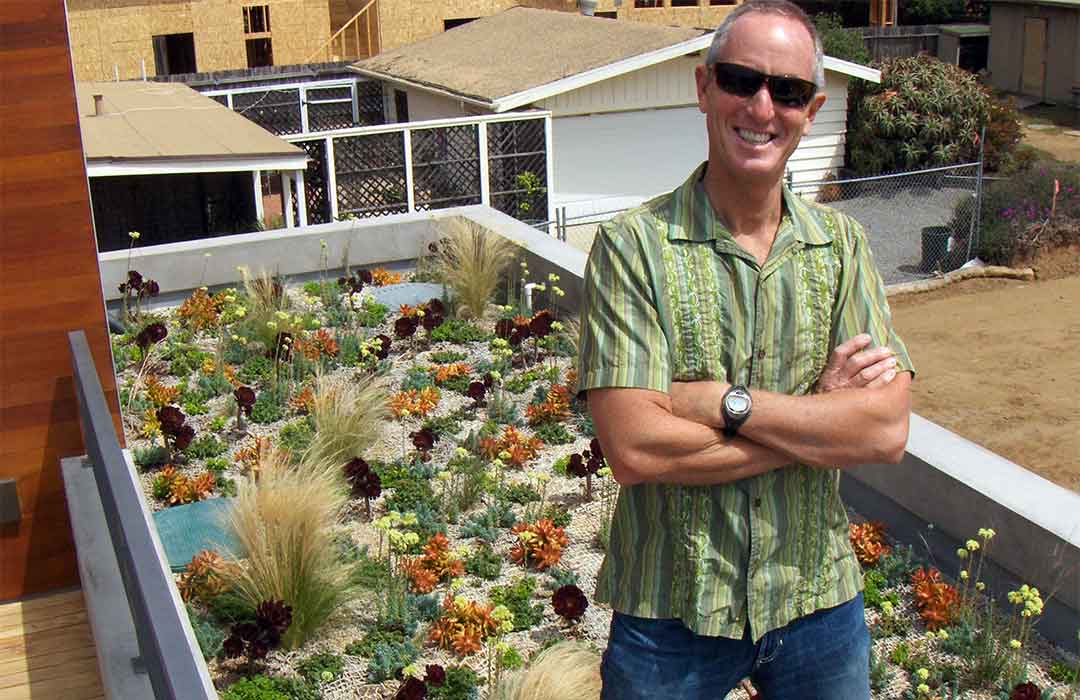Part three of a three part series
We love green roofs and everything they stand for at Good Earth Plant Company and GreenScaped Buildings.
Green roofs are the only feature of a building that actually improves with age, and results in extended life expectancy of a roof. Based on 65-plus years of experience with green roofs in Germany, a green roof can be expected to double or triple (and more!) the life of the underlying conventional roof by protecting it from damage due to debris, UV radiation, and the expansion an contraction caused by changes in temperature. This in turn minimizes construction waste in our landfills.
But it’s also true that almost anywhere in the world, during the first few years of your green roof’s life it needs to be irrigated. In the midst of a drought, every use of water supplies for anything besides the essentials must be justified. We believe the many positive long term benefits of green roofs are worth balancing against the initial investment in irrigation.

One of our favorite projects was this green roof installed in 2013 at the Del Mar home of Rick Williams. Low water use plants were selected.
In many of the world’s climates, the irrigation is turned off after the first couple of years. However, in San Diego, Southern California, and similar arid climates, we need to irrigate a green roof during the hot, dry summer and fall months. Careful planning of the plant palette will minimize but not eliminate water use. Sources other than potable water to consider include rainwater, gray water, purple pipe and AC condensate.
Also known as eco-roofs, vegetated roofs and living roofs, green roofs provide many ecological and aesthetic benefits, including:
- Controlling stormwater runoff, erosion and pollution
- Improving water quality
- Mitigating urban heat-island effects, cooling and cleaning the air
- Conserving energy
- Reducing sound reflection and transmission
- Reducing heating and cooling energy costs
- Creating wildlife habitats
- Improving the aesthetic environment in both work and home settings
A green roof with about four to six inches of growing media (referred to as an “extensive system”) may reduce a building’s cooling needs by 25 percent and prevent heat loss by 26 percent. This can be a substantial energy savings as every one degree Fahrenheit can reduce electricity use for air conditioning by eight percent.
It’s critically important to reduce electricity use, since California generates a significant amount of its electric power through hydro-produced electricity. The amount of hydroelectricity produced varies each year and is largely dependent on snowmelt runoff and rainfall. With these in very short supply, reducing energy use lessens the need to find ways to fill in the gaps by generating electricity that involves burning fossil fuels. In 2014, nearly 16,468 gigawatt-hours (GWh),or 8.37 percent of the state’s total system power came from hydroelectric generation.
If you’re committed to clean energy, green roofs and solar panels make perfect partners. A green roof can improve the efficiency of your solar energy system by as much as 16 percent.
What little rain we do get needs to be maximized. Rainwater harvesting systems installed along with your green roof can help irrigate your green roof as well as reduce stormwater runoff pollution. When rain falls, it is clean, but it immediately picks up pollutants from rooftops and pavement. This pollution is carried into storm drains and then into streams. Collecting storm water from rooftops and directing it to storage tanks so it can later be used for irrigation or flushing decreases the volume and rate of runoff.
Each green roof is unique. Notwithstanding similar designs, many variables result in the reality that no one green roof specification or design is sufficient to guarantee a successful project. The most successful projects are implemented as a design/build contract with an experienced green roof team, including the expertise of green roof horticulturalists to plant the rooftop garden with your microclimate, irrigation needs, and maintenance all in mind. This is the kind of team we have assembled for you at Good Earth Plant Company.
Remember, similar to any garden, the first two years of a green roof are the most important, as this initial period is when the plants are establishing themselves and filling in any gaps for complete coverage. If you are planning to own your home or business for some time, the investment in a green roof system along with the proper irrigation, rainwater harvesting and solar panels can produce an environmental return that is well worth it.
If you missed the earlier parts in our series, read:

